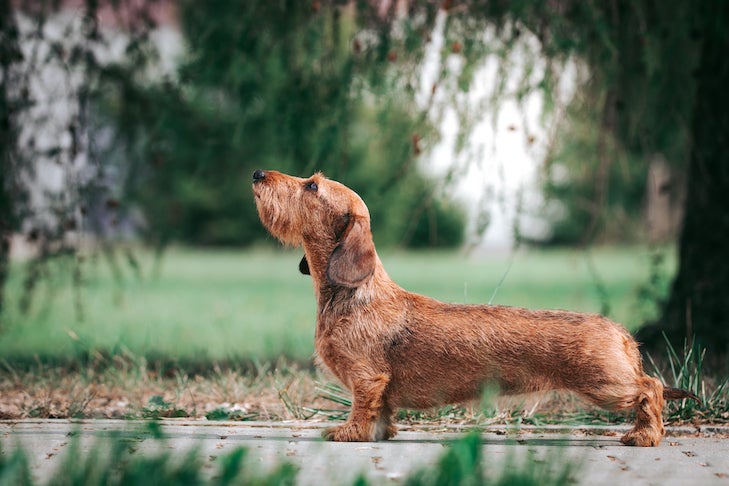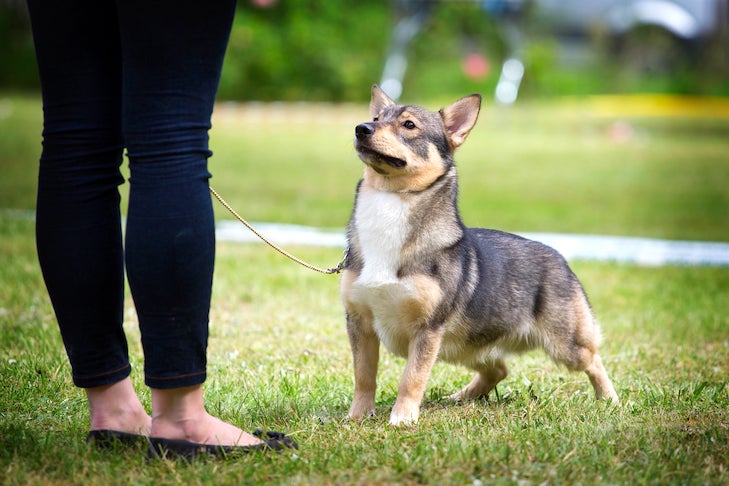
You’ve probably taught your dog to sit and lie down and to stay in those positions until released. But there’s another body position you may have overlooked in your training: stand. Although you won’t use it as often as sit or down, teaching your dog to stand on cue is more useful than you might think and it’s easy to teach with lure and reward training or capturing the behavior. Read on to learn how and why you should teach your dog to stand.
When to Use Stand
The stand position can make your life easier. Imagine putting on your dog’s harness without them wiggling or backing away. Or how about cleaning your dog’s paws when they come inside on a snowy or rainy day. Wouldn’t that be easier if your dog stood still for the process? Many of your day-to-day interactions with your dog can run more smoothly if your dog knows what you expect them to do, and stand is no exception.
Stand can also help during grooming, such as bath time and brushing sessions. And think about how helpful it would be for veterinary exams. Rather than collapsing or trying to escape from the table, you can ask your dog to stand still while the vet checks them over.
Finally, stand is helpful for dog sports. You’ve no doubt seen dogs in conformation shows standing still while the judge evaluates their form from nose to tail. But stand is also used in Rally and Obedience. For example, at the Novice level in Obedience, your dog must stand for an examination to earn their title, and at the Open level, your dog must follow your instructions to switch between sit, down, and stand positions. In Rally, the stand position is used for several exercises in the intermediate and higher classes.

How to Teach Your Dog to Stand on Cue
Now that you know how useful stand can be, it’s time to teach the position. The following steps will help you lure your dog into a stand:
- Place your dog in a sit.
- Hold a treat to your dog’s nose, then pull it straight back away from your dog. As your dog follows the treat, they will stand up.
- Mark the moment your dog stands with a clicker, a marker word like “Yes,” or praise. Then immediately offer your dog the treat while they are still standing.
- After several repetitions, it’s time to fade the lure. This time use an empty hand to lure your dog to a standing position. Again, click/mark/praise once your dog is standing. Then quickly offer a treat from your other hand.
- When your dog is reliably following your empty hand, you’ve taught a hand signal – pulling your hand towards you parallel to the ground. Now you can add a verbal cue. Right before you give your hand signal, say “Stand.” Then click/mark/praise and reward as before.
- After enough repetitions, your dog should respond to the verbal cue alone.
You can also teach your dog to stand by capturing the behavior. That means clicking, marking, or praising your dog when they do a behavior on their own, then delivering a reward. Watch for moments when your dog stands up and be ready to mark and offer a treat. After you’ve captured enough stands, your dog will start offering them to you in hopes of earning a reward. At that point you can add a hand signal and verbal cue to the behavior.
Whether you lure or capture the stand, after your dog understands the position and its cue, you’re ready to add stay to your training. Start with very short intervals, only a second or two, and eliminate any distractions. Don’t start adding distance until your dog can hold their stand for at least 30 seconds and you’ve introduced distractions like tossing a ball or jogging on the spot.
Troubleshooting Stand
When you first start to lure your dog into a stand, they might refuse to leave their sit position, especially if you’ve heavily rewarded sit in the past. You can encourage your dog to break their sit by raising your excitement level. Act goofy, clap your hands, or slap your thighs before offering the lure. Or try luring them from a down position instead. Plus, be sure to use a super enticing treat that your dog will be willing to follow.
When you’re fading the lure, your dog might fail to follow your empty hand. If so, try a few more repetitions with the treat lure, then try again without the treat. If your dog still won’t follow your empty hand, try rubbing a stinky treat between your fingers first. The smell should be enough to get your dog interested in standing up to follow your fingers.
Finally, be sure to give your dog their treat while they are standing. Otherwise, you’re reinforcing whatever they are doing when they get the treat, whether that’s sitting back down or walking away. To help with your timing when fading the lure, have a treat ready in your other hand while you lure with the empty one. Then you can be sure to deliver the reward on time. You can also use a treat pouch to keep treats easily accessible. By following these simple steps, you will have your dog standing on cue, for dog sports to vet visits, whenever the need arises.


